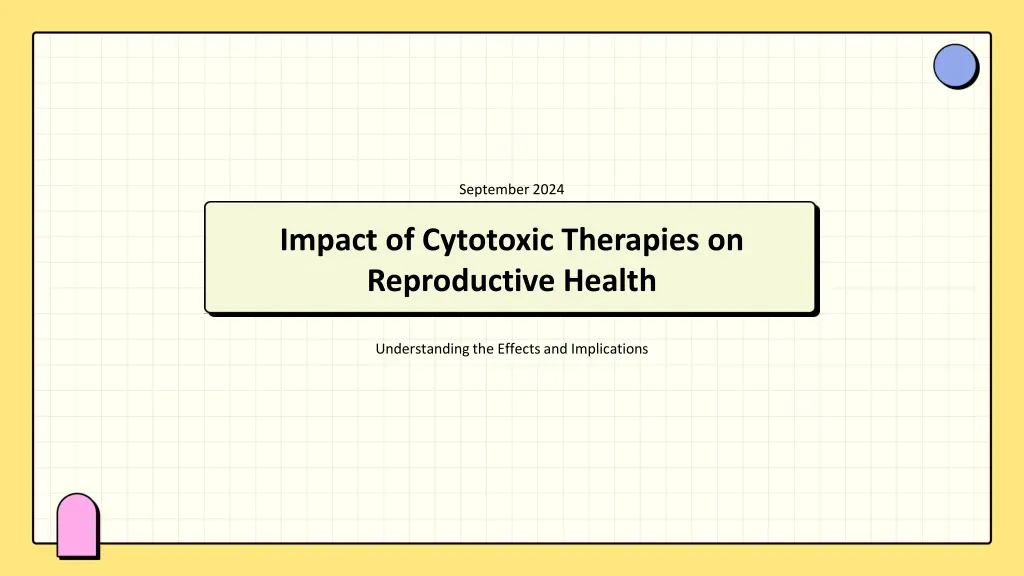
Understanding the Impact of Cytotoxic Therapies on Reproductive Health
Explore the effects of cytotoxic therapies on reproductive health, including teratogenic risks, male offspring outcomes, female survivor risks, and prevalence of congenital anomalies. Learn about legislation for fertility preservation, genetic considerations post-treatment, and more to make informed decisions regarding cancer treatment and reproductive health.
Uploaded on | 0 Views
Download Presentation

Please find below an Image/Link to download the presentation.
The content on the website is provided AS IS for your information and personal use only. It may not be sold, licensed, or shared on other websites without obtaining consent from the author. If you encounter any issues during the download, it is possible that the publisher has removed the file from their server.
You are allowed to download the files provided on this website for personal or commercial use, subject to the condition that they are used lawfully. All files are the property of their respective owners.
The content on the website is provided AS IS for your information and personal use only. It may not be sold, licensed, or shared on other websites without obtaining consent from the author.
E N D
Presentation Transcript
September 2024 Impact of Cytotoxic Therapies on Reproductive Health Understanding the Effects and Implications
Table of Contents 5 Legislation for Fertility Preservation 1 Teratogenic Effects of Treatment 6 Cytotoxic Agents in Men 2 Impact on Male Offspring Female Survivor Risks 7 Cranial Irradiation Impact 3 Congenital Anomalies Prevalence 8 Preservation of Fertility 4
9 Genetic Considerations Post-Treatment 10 Closing Thoughts
Teratogenic Effects of Treatment 1. Cytotoxic therapies during pregnancy can cause teratogenic effects on the fetus, leading to potential complications. 2. The risk of mutagenic alterations to germ cells raises concerns for fertility recovery post-treatment. 3. It's crucial to assess the risks versus benefits when treating pregnant women for cancer. Photo by Pexels 4. Counseling plays an important role in decision-making regarding therapy during pregnancy.
Impact on Male Offspring 1. A large study of 3,915 cancer survivors found no increased risks for male offspring from cancer treatments. treatments. 2. Male cancer survivors showed no differences in congenital abnormalities when compared to controls. 3. This indicates a reassuring perspective on male reproductive health post-cancer treatment. Photo by Pexels 4. Continued research is vital to confirm these findings and ensure future pregnancies are safe.
Female Survivor Risks 1. Female cancer survivors exhibit an increased risk of of preterm births and low birth weight in their offspring. offspring. 2. No significant differences were observed in major congenital abnormalities for female survivors. 3. Understanding these risks is essential for making informed decisions about pregnancy after treatment. Photo by Pexels 4. Awareness can lead to better prenatal care and outcomes for these mothers and their children.
Congenital Anomalies Prevalence Prevalence 1. Congenital anomalies prevalence in childhood cancer cancer survivors is around 3%, similar to the national national average in the US. 2. This statistic can help alleviate concerns for patients regarding potential birth defects from treatments. 3. Health professionals should communicate these findings to provide reassurance to patients. Photo by Pexels 4. Further studies are essential to maintain updated data on long-term outcomes.
Legislation for Fertility Preservation 1. Physician advocates have successfully influenced laws laws regarding insurance coverage for fertility preservation. 2. Since the 1980s, 20 states have enacted fertility insurance laws promoting access to necessary treatments. 3. Understanding these laws can empower patients to seek support where needed. Photo by Pexels 4. Patient advocacy is key for ensuring equitable access to fertility preservation options.
Cytotoxic Agents in Men 1. Cytotoxic agents affect male reproductive health, notably notably impacting sperm production and quality. 2. The testis structure is critical for understanding how these therapies might lead to dysfunction. 3. Addressing these effects is crucial for preserving male fertility after treatment. 4. Regular assessments and counseling are recommended Photo by Pexels for male cancer survivors.
Cranial Irradiation Impact 1. Cranial irradiation has been linked to potential gonadal gonadal dysfunction in both sexes. 2. Understanding these effects can guide treatment and fertility preservation decisions. 3. Research into the specifics of gonadal impact is ongoing to enhance patient care. 4. Collaboration between oncology and reproductive Photo by Pexels specialists is essential.
Preservation of Fertility 1. Fertility preservation options exist for both males and and females undergoing cancer treatment. 2. Understanding these options is vital for reproductive health post-treatment. 3. Emerging technologies continue to enhance our approach to preserving fertility. 4. Counseling patients on these choices can improve their Photo by Pexels future family planning opportunities.
Genetic Considerations Post- Treatment 1. There are theoretical risks concerning genetic alterations alterations after treatment, needing careful consideration. 2. Patient education on these risks allows for informed family planning discussions. 3. Research continues to assess the long-term genetic outcomes of survivors. Photo by Pexels 4. Awareness and research are key components of effective patient support.
Closing Thoughts 1. Informed decisions lead to better health outcomes for outcomes for families dealing with cancer treatments. treatments. 2. Ongoing research and advocacy shape the future of reproductive health post-cancer. 3. Patients should feel empowered to seek information and support regarding their reproductive health. Photo by Pexels 4. Together, we can ensure a healthier future for survivors and their families.
